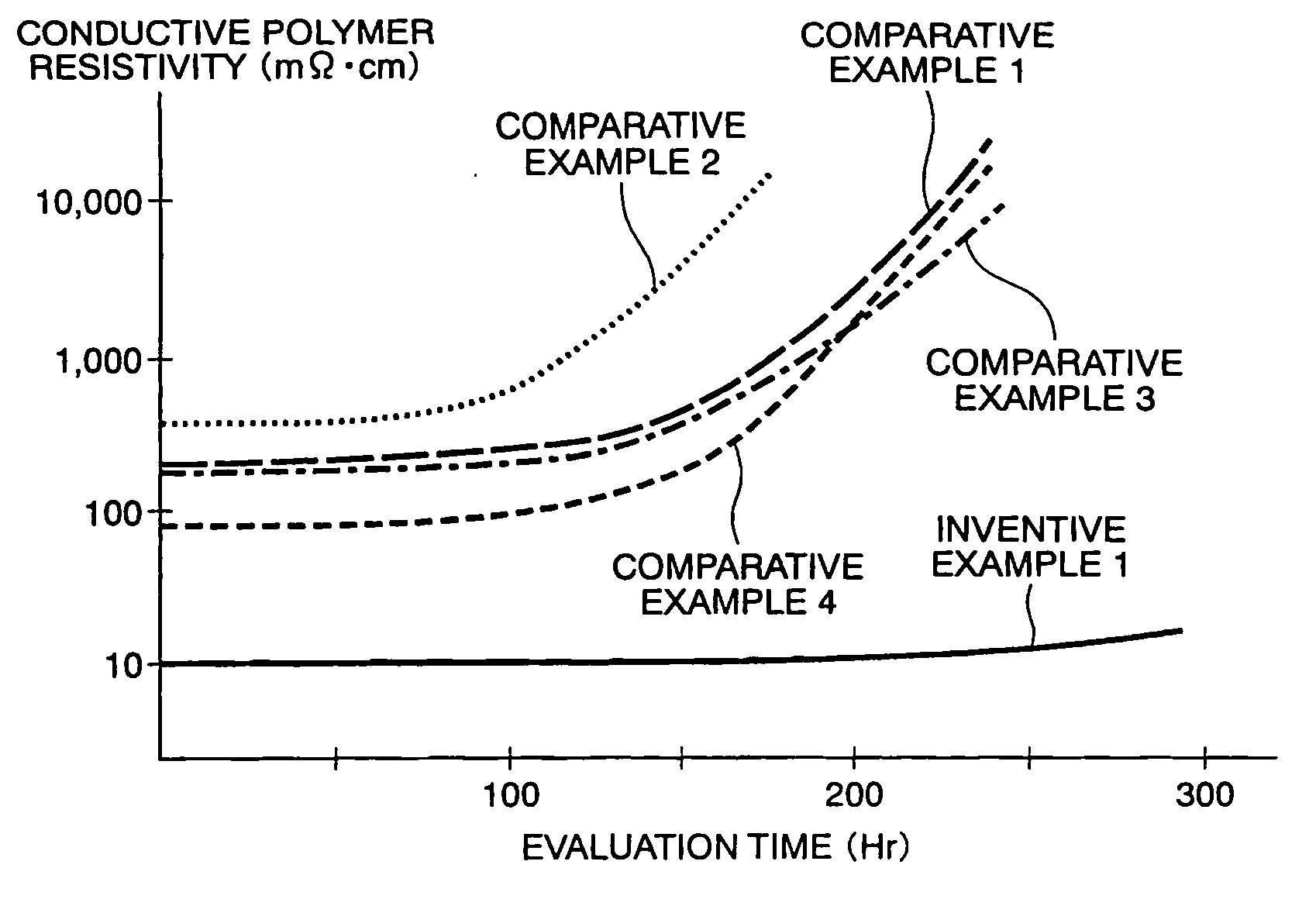Electrically conductive polymer composition and solid electrolytic capacitor using the same
a technology of polymer composition and solid electrolytic capacitor, which is applied in the direction of electrolytic capacitor, capacitor electrode, liquid electrolytic capacitor, etc., can solve the problems of low resistance, low stability at high temperatures, and inability to meet the needs of high temperature stability, so as to reduce the resistance and low resistance
- Summary
- Abstract
- Description
- Claims
- Application Information
AI Technical Summary
Benefits of technology
Problems solved by technology
Method used
Image
Examples
example 1
[0027] In Example 1 of this invention, the weight ratio composition of respective materials to be used was set to EDT:1, PSSA:2.6, NSA:1.5, and oxidant:1 given that pure water was 100. PSSA was used in the form of a 20% aqueous solution of PSSA having an average molecular weight of 14,000, NSA was used in the form of a 10% aqueous solution, and ammonium peroxodisulphate (hereinafter referred to as “APS”) powder was used as the oxidant. When the aqueous solution was used, the weight ratio was given as a value corresponding to the solid part thereof. The foregoing materials ad the pure water were put into a container and then stirred with a stirrer so that polymerization proceeded. In this event, APS serving as the oxidant was added dividedly after uniformly stirring and mixing EDT, PSSA, and NSA being the base materials. This is because if a large amount of the oxidant is added at one time, variation in molecular weight of a conductive polymer to be obtained increases so that there a...
example 2
[0029] In Example 2 of this invention, conductive polymer aqueous solutions were produced in the same manner as in Example 1 except that the weight composition ratios of NSA were set to 0.5. 1.0, and 2.0 relative to pure water 100, respectively (hereinafter, the respective compositions will be referred to as Examples 2a, 2b, and 2c). These solutions were dropped on glass plates to obtain coating films like in Example 1. The resistivity of each coating film is shown in Table 2 below in comparison with Example 1. FIG. 2 shows changes in resistivity of those coating films when they were left standing in an atmospheric atmosphere at 150° C.
TABLE 2MeasurementInventiveInventiveInventiveInventiveObjectExample 1Example 2aExample 2bExample 2cResistivity10 mΩ· cm50 mΩ· cm13 mΩ· cm17 mΩ· cm
[0030] It is understood from Table 2 that although there is almost no difference between Example 1 and Examples 2a to 2c, the coating film of Example 1 exhibits the lowest resistivity and, further, it is u...
example 3
[0031] In Example 3 of this invention, a solid electrolytic capacitor 101 as shown in FIGS. 3A and 3B was produced by the use of the conductive polymer aqueous solution produced in Example 1.
[0032] Tantalum was used as a valve-acting metal for the solid electrolytic capacitor shown in FIG. 3A and, according to the known method described in patent document 5 or the like, a tantalum porous body 1 was produced from tantalum powder and an oxide film 2 was formed on the metal surface of the porous body 1 by anodic oxidation. By chemical oxidation polymerization using a pyrrole monomer and dodecylbenzene sulfonic acid iron, a polypyrrole conductive polymer layer 3 was formed, as a first solid electrolyte layer, on the oxide film 2 inside the tantalum porous body 1. In the example of patent document 5, a conductive polymer layer is then formed by electrolytic polymerization. However, in Example 3 of this invention, such a layer was formed by the use of the conductive polymer aqueous solut...
PUM
| Property | Measurement | Unit |
|---|---|---|
| weight ratio | aaaaa | aaaaa |
| weight ratio | aaaaa | aaaaa |
| weight ratio | aaaaa | aaaaa |
Abstract
Description
Claims
Application Information
 Login to View More
Login to View More - R&D
- Intellectual Property
- Life Sciences
- Materials
- Tech Scout
- Unparalleled Data Quality
- Higher Quality Content
- 60% Fewer Hallucinations
Browse by: Latest US Patents, China's latest patents, Technical Efficacy Thesaurus, Application Domain, Technology Topic, Popular Technical Reports.
© 2025 PatSnap. All rights reserved.Legal|Privacy policy|Modern Slavery Act Transparency Statement|Sitemap|About US| Contact US: help@patsnap.com



